
Eucalyptus youngiana, commonly known as large-fruited mallee, Ooldea mallee and yarldarlba, is a species of mallee, less commonly a tree, that in native to arid and semi-arid areas of southern Western Australia and South Australia. It has rough, fibrous bark on some or all of the trunk, smooth bark above, lance-shaped adult leaves, flower buds in groups of three, red, pink or bright yellow flowers and short, broad, conical fruit.
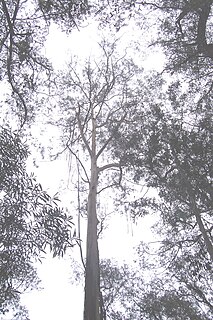
Eucalyptus smithii, commonly known as the gully gum, gully peppermint, blackbutt peppermint, or ironbark peppermint, is a species of medium-sized to tall tree, sometimes a mallee, that is endemic to southeastern Australia. It has rough, compact bark on the trunk, smooth ribbony bark above, narrow lance-shaped adult leaves, flower buds in groups of seven, white flowers and cup-shaped, bell-shaped or hemispherical fruit.
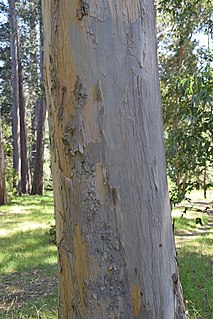
Eucalyptus nitida, commonly known as the Smithton peppermint, is a species of tree or mallee that is endemic to Tasmania. It has varying amounts of loose, fibrous or flaky bark, lance-shaped to curved adult leaves, flower buds in groups of nine to fifteen, white flowers and cup-shaped to hemispherical fruit.
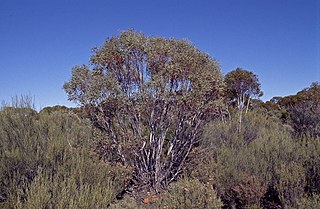
Eucalyptus leptopoda, commonly known as the Tammin mallee, is a species of mallee or rarely a tree, that is endemic to Western Australia. It has smooth mottled grey or brownish bark, sometimes with rough bark near the base, linear to curved adult leaves, flower buds usually in groups of seven and eleven, creamy white flowers and hemispherical to flattened spherical fruit.
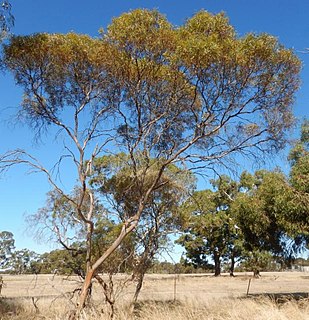
Eucalyptus leptophylla, commonly known as the March mallee, slender-leaved red mallee or narrow-leaved red mallee, is a species of mallee that is endemic to inland Australia. It has smooth greyish bark, linear to narrow lance-shaped, oblong or curved adult leaves, flower buds in groups of between seven and thirteen, creamy white flowers and cup-shaped, barrel-shaped or hemispherical fruit.

Eucalyptus morrisii, commonly known as grey mallee, is a species of mallee or straggly tree that is endemic to western New South Wales. It has rough, fibrous or flaky bark on some or all of the trunk, smooth greyish bark above, lance-shaped adult leaves, flower buds usually in groups of three, white flowers and conical or hemispherical fruit.

Eucalyptus aspratilis, commonly known as the soak yate or inland mallee-yate, is a mallee that is endemic to Western Australia. It has rough bark near its base, smooth silvery greyish bark above, lance-shaped adult leaves, pendulous buds in groups of seven, pale yellow or cream-coloured flowers and cylindrical fruit.

Eucalyptus comitae-vallis, commonly known as Comet Vale mallee, is a mallee that is endemic to the south-west of Western Australia. It has rough, flaky to ribbony bark on the trunk and larger branches, smooth withish bark above, linear to narrow lance-shaped adult leaves, flower buds in groups of seven to eleven, white flowers and barrel-shaped, conical or cup-shaped fruit.
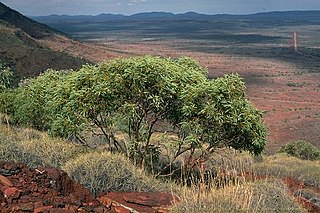
Eucalyptus ewartiana, commonly known as Ewart's mallee, is a species of mallee that is endemic to Western Australia. It has reddish brown, minni ritchi bark, narrow lance-shaped to egg-shaped adult leaves, flower buds in groups of seven, white flowers and conical to hemispherical fruit.

Eucalyptus neutra, commonly known as the Newdegate mallee, is a species of mallee that is endemic to the south-west of Western Australia. It has greyish bark, lance-shaped adult leaves, flower buds usually in groups of seven, pale yellow to white flowers and barrel-shaped to shortened spherical fruit.
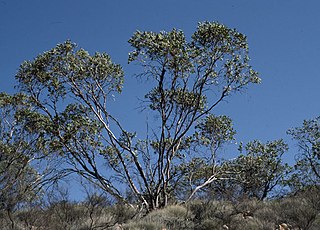
Eucalyptus oxymitra, commonly known as the sharp-capped mallee, is a species of mallee that is endemic to remote parts of Central Australia. It has rough bark on the trunk, smooth greyish bark above, lance-shaped to egg-shaped adult leaves, flower buds in groups of seven, white to pale yellow flowers and hemispherical fruit.

Eucalyptus sessilis, commonly known as Finke River mallee, red bud mallee or river mallee, is a species of mallee that is native to the Northern Territory and central areas along the border of Western Australia. It has smooth bark, sometimes with ribbon of old bark near the base, lance-shaped to egg-shaped or elliptical adult leaves, flower buds in groups of seven, creamy yellow flowers and hemispherical fruit.

Eucalyptus striaticalyx, commonly known as Cue York gum or kopi gum, is a species of tree or mallee that is endemic to Western Australia. It has thick, rough, fibrous bark on the trunk and larger branches, lance-shaped adult leaves, flower buds in groups of between seven and thirteen, creamy white flowers and conical to cup-shaped fruit.
Eucalyptus tortilis is a species of mallet and a gimlet that is endemic to the southwest of Western Australia. It has smooth bark, lance-shaped adult leaves, flower buds in groups of seven, creamy white flowers and hemispherical to cup-shaped fruit.

Eucalyptus trivalva, commonly known as Victoria Spring mallee or desert mallee, is a species of mallee or small tree that is endemic to arid areas of central Australia. It has rough, partly shed bark on some or all of the trunk, smooth bark above, lance-shaped to elliptical adult leaves, flower buds in groups of nine or eleven, white flowers and cup-shaped, cylindrical or conical fruit.
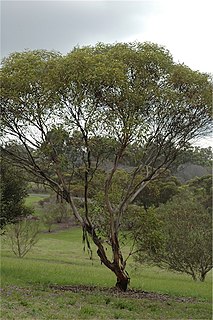
Eucalyptus calcareana, commonly known as the Nundroo mallee or Nundroo gum, is a mallee or a small tree that is endemic to the south coast of Australia. It has smooth, greyish or cream-coloured bark, lance-shaped or curved adult leaves, flower buds in groups of seven or nine, creamy-white flowers and cup-shaped to conical fruit.

Eucalyptus ceratocorys, also known as the horn-capped mallee, is a mallee that is native to South Australia and Western Australia. It has rough, ribbony bark at the base of its trunk, smooth greyish bark above, lance-shaped adult leaves, flower buds in groups of seven or nine with ridges along the sides, white to cream-coloured flowers and cylindrical fruit.

Eucalyptus cylindrocarpa, commonly known as the woodline mallee, is a species of mallee that is endemic to Western Australia. It has mostly smooth bark, sometimes with loose fibrous or flaky bark near the base of the trunk, linear to lance-shaped or curved adult leaves, flower buds in groups of seven, nine or eleven and cylindrical to barrel-shaped fruit.
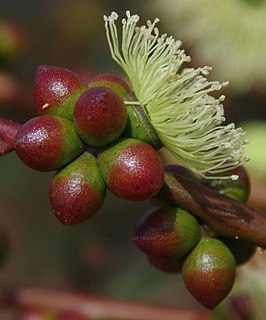
Eucalyptus terebra, commonly known as Balladonia gimlet, is a species of gimlet that is endemic to Western Australia. It has satiny or glossy bark on its fluted trunk, linear to narrow lance-shaped adult leaves, flower buds in groups of seven, yellowish flowers and conical to hemispherical fruit. It is one of the seven species of gimlet.
Eucalyptus minniritchi is a species of multi-stemmed, spreading mallee that is endemic to Central Australia. It has glossy, brown to grey, "minni ritchi" bark on the trunk, elliptical to egg-shaped adult leaves, flower buds mostly in groups of seven, pale creamy yellow flowers and conical to hemispherical fruit.





















